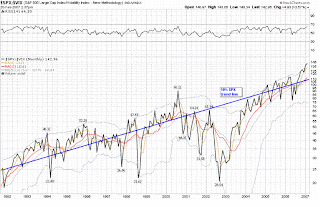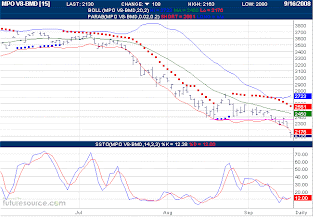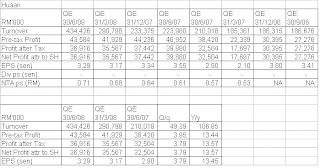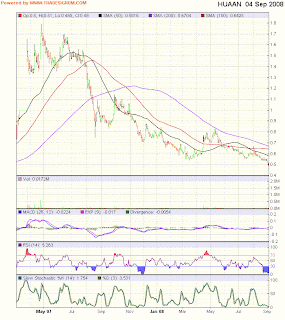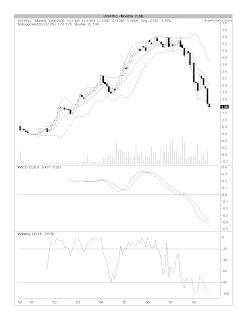Before I proceed to answer the above question, I like to say that we are going into the area of forecasting, which is not one of the strong point of technical analysis. Nevertheless, it is good to examine the potential downside for the market, in term of possible point lost as well as time taken, before the bull returned.
Let's proceed to define what's a bear market using the following:
1) the monthly chart for the past 15 years;
2) MACD indicator (with moving average calculated on "weighted" basis); and
3) Williams' %R indicator.
As noted in an earlier post (go
here), we have seen that a hook-down in the MACD can pinpoint a potential market top. I have added the Williams' %R indicator to weed out period when we have a hook-down in the MACD but the index seems to defy gravity (such as the period from 2004 to 2006). During that period, the Williams' %R indicator did not drop into the oversold territory. So, a bear market happened when the MACD has hooked down & the Williams' %R has gone into the oversold territory.
From Chart 1 below, we can see that there were three periods which satisfied the above conditions for a bear market. They are denoted as 'A, B & C' but we can exclude 'C' because it is too shallow & short to be a true bear market. Looking at 'A' & 'B', we can see that a bear market can last 17-19 months (or, averaging 18 months).
 Chart 1: KLCI's monthly chart as at August 28th, 2008 (source: Quickcharts)
Chart 1: KLCI's monthly chart as at August 28th, 2008 (source: Quickcharts)Using Fibonacci retracement to estimate the potential target in the current bear market, we can see that a retracement of 38.2%, 50.0% & 61.8% of the distance traveled from the 1998 low of 261 to the 2008 high of 1524 would put the market at about 1041, 892 & 743, respectively (see Chart 2 below). For more on Fibonacci retracement, go
here,
here &
here.
 Chart 2: KLCI's monthly chart as at August 28th, 2008 [overlaid with Fibonacci retracement] (source: Quickcharts)
Chart 2: KLCI's monthly chart as at August 28th, 2008 [overlaid with Fibonacci retracement] (source: Quickcharts)Based on the above, I think that the bear market could last another 9 months to the middle of next year. If that were to happen, it is quite likely that the market will retrace more than 38.2% (to 1041) since we are currently at 1045 (at the close of this morning session). While the 38.2%-retracement (to 1041) is still possible in the scenario of a big swing market (like 1994-1996, as highlighted in
this post), it is more likely that the retracement will be 50% (to 892) or, even 61.8% (to 743).
With the KLCI now breaking the long-term uptrend line support at 1050-60, we have to very careful with all trading position. Those buying for long-term investment purpose may continue to do so, albeit at a slower pace. On the other hand, if we have a quick recovery above the long-term uptrend line (say, 1050-60), then the uptrend line will stay intact for now. And, if this is followed through with a rally above the immediate downtrend line (say, 1090-1100), then the scenario of a big swing market (with the 38.2%-retracement to the potential target of 1041) may play out. So, watch the market closely for the next few days!








